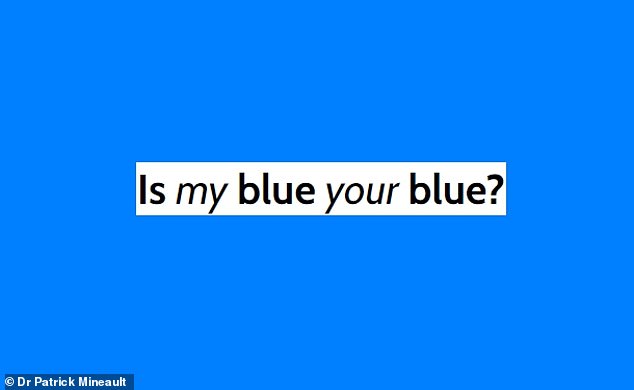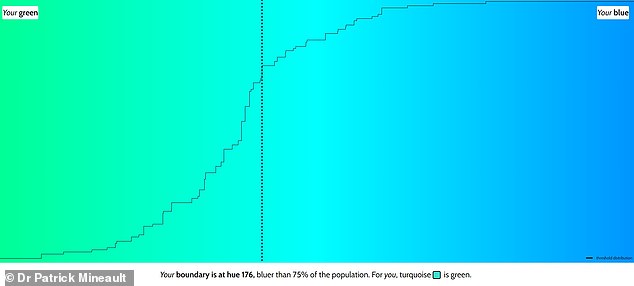What is blue to you? Take the test to see how your color perception compares to the rest of the population
From the sky to the sea, there are several things on Earth that we all know are blue.
But where does blue end and green begin?
In hopes of answering this question, Dr. Patrick Mineault, a neuroscientist and AI researcher, has developed a new test.
The test, titled ‘Is My Blue Your Blue?’, presents a range of different shades and simply asks whether you think each shade is blue or green.
How does your color perception compare to that of the rest of the population?
During the testyou will be presented with a series of six shades and asked to click one of two buttons: ‘This is blue’ or ‘This is green’.
“Colors are often represented in the HSL (hue, saturation, lightness) color space,” Dr. Mineault explains.
‘Tint 120 is green, and tint 240 is blue. The test focuses on blue-green tints between 150 and 210.’
At the end of the test you will see where your blue-green boundary is and how it compares to the rest of the population.
“In previous experiments, we found that people’s answers were around 175, which coincidentally is the same as the named HTML color turquoise,” Dr. Mineault said.
This is interesting because the nominal boundary between blue and green is 180, the named HTML color cyan.
During the test you will be shown a series of six shades and asked to click one of two buttons: ‘This is blue’ or ‘This is green’.

At the end of the test you will be shown where your blue-green border is and how it compares to the rest of the population.
“That means most people tend to think of cyan as blue.”
MailOnline’s Shivali Best took the test and found her cut-off was 176.
“Your limit is at shade 176, bluer than 75% of the population. For you, turquoise is green,” the test tells me.
Although we all learn the basic colors as children, Dr. Mineault explains that color vision is “difficult to measure.”
“Vision scientists use specialized calibrated equipment to perceive colors,” he said.
‘Graphic designers use physical color charts, such as Pantone, so they can communicate colors clearly.
‘Here we test how you categorize colors using your monitor or phone.’
Dr. Mineault stresses that the test is “far from perfect” because monitors and screens can vary in calibration.

Shivali Best from MailOnline took the test and found her cut-off was 176. ‘Your cut-off is shade 176, bluer than 75% of the population. For you, turquoise is green,’ the test tells me
“The validity of the conclusion is limited by the calibration of your monitor, ambient lighting, and filters such as night mode,” he added.
‘Despite these limitations, the results should have good test-retest reliability on the same device, under the same ambient light. This can be verified by performing the test multiple times.’
Don’t panic if you get very different results than your friends.
“If you get abnormal results, it doesn’t mean there’s anything wrong with your vision,” Dr. Mineault explains.
‘You may have an odd way of naming colors, or your monitor and lighting may be unusual.’
At the end of the test, you will be given the opportunity to submit your answers anonymously so that researchers can collect them for further study.
Dr. Mineault reassured: “We do not store any information that could personally identify you.”
